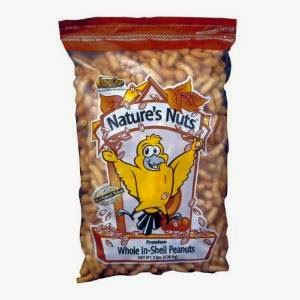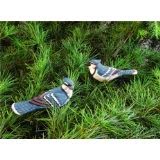 by Adele Barger Wilson, author of Bonding with the Barn Swallows
by Adele Barger Wilson, author of Bonding with the Barn SwallowsPhotos and text © 2014 Adele Wilson
Here in Eastern West Virginia, as well as in much of the Eastern and Central U.S., we have
three beautifully colored bird species that stay around all winter -- Blue
Jays, Cardinals, and Eastern Bluebirds.
This post will focus on Blue Jays.
The plumage of the Blue Jay is probably the most fascinating
of all of our local birds. While the Blue Jay's
breast is a light blue color and its face a whitish blue, its crest, upper
wings, and the back of its head all exhibit a brilliant solid blue.
The black accents on the Blue Jay's face add to its
mystique. What truly gives this bird its
unique appearance, however, is the mosaic pattern on its lower wings and tail,
consisting of tones ranging from mid blue to bright turquoise, amazingly interspersed with black and white.
During the first winter that I put out suet cakes, I would
hang the cakes from a redbud tree that was growing beside my porch. My landlord had transplanted the tree from
the woods years ago.
 |
| Blue Jay on Redbud Tree |
It was my first experience in hanging out a suet feeder; so
I did not know what to expect. To my
delight, among those who came to feast on the suet cakes that winter were the
majestic Blue Jays.
Unfortunately, the redbud tree seemed to be developing a
disease. Its trunk had split open, and
the branches were starting to split, also.
The following summer, my landlord chopped it down.
And so it was that during the following winter I no
longer had a tree beside my porch. I was forced
to put the suet cakes on a different tree, one that was farther away. That was the “tree by the driveway” that I
mentioned in Part 1.
Unfortunately, no Blue Jays came to my suet feeders on the
tree by the driveway. I didn't know
exactly why this was. I suspected that it
had something to do with the Blue Jays being able to find food that other
people had put out for them.
For one thing, Blue Jays LOVE peanuts in the shell, in other
words, whole peanuts. They also love
shelled peanuts and shelled or unshelled sunflower seeds. Shelled sunflower seeds come in two varieties
– striped and black oil – and Blue Jays love them both. Cracking shells is no problem for these
birds.
 |
| Blue Jay Peanut Feeder |
Here is an example of a feeder that Blue Jays would love –
perfect for peanuts in the shell! You can click on the image to find out more. Unfortunately, with the high winds around here, I have nowhere to hang such a feeder. Hung from the tree by the driveway, it could easily hit a parked vehicle if the wind were to blow it down. The only other choice would be the mimosa tree, whose branches are too delicate to hold it intact.
 |
| Peanuts in the Shell |
And here is a good source of Peanuts in the shell to attract
not only Blue Jays, but also other birds such as Titmice, Chickadees, and
Nuthatches. If you click on the image, you can find out how to order this 10 lb supply of unshelled peanuts.
Although I was concerned that the local Blue Jay population had somehow undergone a dire fate, I was nevertheless relieved that the Blue Jays were not competing with the other birds at the feeders. As beautiful as they are, Blue Jays often bully the smaller birds and prevent them from eating. But I still wondered what had happened to them.
In early October, I went to visit a friend who has a huge
oak tree in front of his house. As I approached
his door, I saw a dozen or more Blue Jays momentarily perching on the branches
of the oak tree, and then quickly swooping to the ground.
I soon observed that the Blue Jays were knocking
acorns, one-by-one, from the tree. Each time a Blue Jay would dislodge an acorn, it would quickly leave its branch and fly down to the ground to retrieve it. Once it had gathered the acorn in its beak, it would suddenly lift off and fly over the building and out of sight.
 |
| Blue Jay gathering acorns |
But the Blue Jays kept returning to the oak tree to gather
more acorns. Again, each bird would
first land on a branch, knock an acorn to the ground below, and then swoop to
the ground to pick it up.
Soon I noticed that the Blue Jays’ mouths looked conspicuously
full. Their checks were bulged out, as
if they were holding more than one acorn at a time. Upon looking more carefully, I noticed that,
besides gathering acorns, they were also gathering unshelled peanuts!
The mystery was soon solved when my friend’s next-door
neighbor told me that her grandson had thrown peanuts out on the lawn to feed
the squirrels. Little did she know that the peanuts would attract Blue Jays!
I later read that Blue Jays will actually bury acorns and
peanuts for safe keeping, much as squirrels do! They will eat some of the
acorns immediately, but save the others to bury and find later during the cold
winter months.
One day I was wondering if we still had Blue Jays in our
neighborhood. On a couple of occasions
during the summer, I had identified a couple of these birds through binoculars
on the neighbor’s property, quickly flitting from trees to fences, then briefly
to the ground, and then up again into the trees. But they had never come close to my feeders and I
had not seen them since those two occasions.
During my regular backyard bird watches, I began using
binoculars to view the distant trees.
Over a period of time, I began to notice movement --- flashes of blue
light moving from tree to tree. Upon realizing
that the most of the trees were oaks, it suddenly dawned on me that those flashes of light must be Blue Jays!
What a relief it was to know that our Blue Jay neighbors had
not perished! Thanks to my newly gained knowledge of these birds’ love for acorns, I had learned where to look for Blue Jays -- on or near oak trees! And, despite the absence of Blue Jays at my
feeders, it is consoling to know that we still have these marvelous wonders of
the Avian Kingdom around us.
Here are some gift suggestions that feature the awesome beauty of the Blue Jay. You can click on the images to find out more:
 |
| Suncatcher - Beautiful! |
 |
| Blue Jay on Snowy Branch - Charming Figurine! |
 |
| Enameled Box - Inlaid Czech Crystals |
 | ||||||
| Porcelain Christmas Ornament - Gorgeous! |
 |
| Blue Jay Feeder - Sunset Vista Designs |
 |
| Clip Christmas Tree Ornaments (2) |


No comments:
Post a Comment